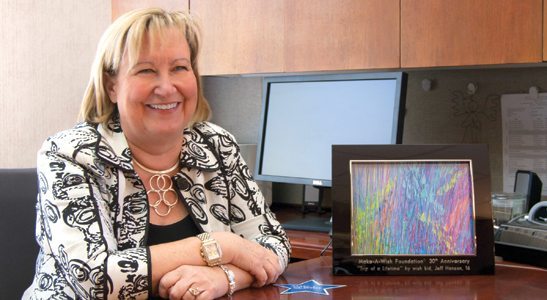Elizabeth Reich, president and CEO of Make-A-Wish Foundation of Arizona, discusses how Make-A-Wish was founded, its challenges, how they make wishes happen and more.
Elizabeth Reich
Title: President and CEO
Company: Make-A-Wish Foundation of Arizona
What is something people don’t know about Make-A-Wish?
Most people don’t know that it was founded here in Arizona in 1980 after some DPS officers and a customs agent learned of a boy with leukemia whose one wish was to become a police officer. They decided to help make his dream happen. He got a uniform, was checked out on mini-motorcycle, and the experience was very meaningful to him. When he died, he was buried in the uniform and he was issued. After the officers saw the impact the wish had on the boy and his family, they said , ‘We should do this again,’ and it grew into what it is today. We have 62 chapters in the U.S. and we are in 35 countries worldwide. Make-A-Wish is Arizona’s gift to the world.
Video by Cory Bergquist
What has been your biggest challenge in this struggling economy?
We are 100 percent dependent on dollars from people and corporations to make our wishes come true and those dollars are fewer and farther between. People know that Make-A-Wish does great things, but sometimes they don’t see them as necessary things.
How do you show them that they are a necessity?
Fortunately, a 2010 study of more than 2,000 Make-A-Wish families and volunteers shows the impact of a wish beyond that moment — the impact on the family, the impact on the volunteers and the impact on that child through the rest of his or her life. Many of our Make-A-Wish children live to be adults. That wish experience has impact on their ability to recover from their illness. So as a result of the wish impact study, we can now say our wishes are not a ‘nice to have,’ they are a ‘need to have.’
What is your most rewarding moment at CEO of Make-A-Wish?
It’s always the most recent moment. There was a young lady who graduated early from high school and was No. 3 in her class. Originally, her wish was to go to Italy. But her wish changed. She said, ‘I want to focus on school. I want to focus on becoming a doctor.’ So her wish was for a laptop computer. Not only was her wish for a laptop granted, but she got an iPad, an iPod, and a desk to put the laptop on. She was so gracious and so thankful. It’s something that is going to enrich her life for years to come and it was her one true wish.
Are there common threads in the wishes?
Our wishes fall into four categories: I wish to be, I wish to go, I wish to have, or I wish to meet. But more and more, kids today are adding a fifth category: I wish to give. They use their wishes to give back. We are working with one girl whose wish is to have a national forum where she can talk about the importance of being a bone marrow donor. We are working with morning shows right now to arrange a platform for her so she can get her message out.
How do you make the wishes happen?
We have wonderful staff members called wish managers. They have to be part travel agent, part logistician, be multi-skilled, and have to work in concert with our volunteers. When you’re granting 251 wishes, like we did last year, you’re dealing with a lot of logistics and a lot of juggling. I like to say that we cry here every day. We cry for good things and we cry for bad things. But we know what we’re doing makes a difference for that child and for that family and that feels so good.
Vital Stats: Elizabeth Reich
- Joined Make-A-Wish Foundation of Arizona in 2010
- Graduated from Whittier College with a degree in political science
- Previous jobs include vice president of advancement at Childhelp; CEO at VisionQuest 20/20; and vice president of development at Banner Health Foundation
- From 1998-2003, was executive director of what is now called The Governor’s Office for Children, Youth and Families, consisting of the Governors’ Divisions for Women, Children, Prevention of Family Violence, Drug Policy, Volunteerism, Community Outreach and Character Education
- Raised money to support Banner Desert Medical Center and Banner Children’s Hospital in Mesa. Led the first stages of a capital campaign, successfully obtaining several seven-figure gifts
Arizona Business Magazine January/February 2012




